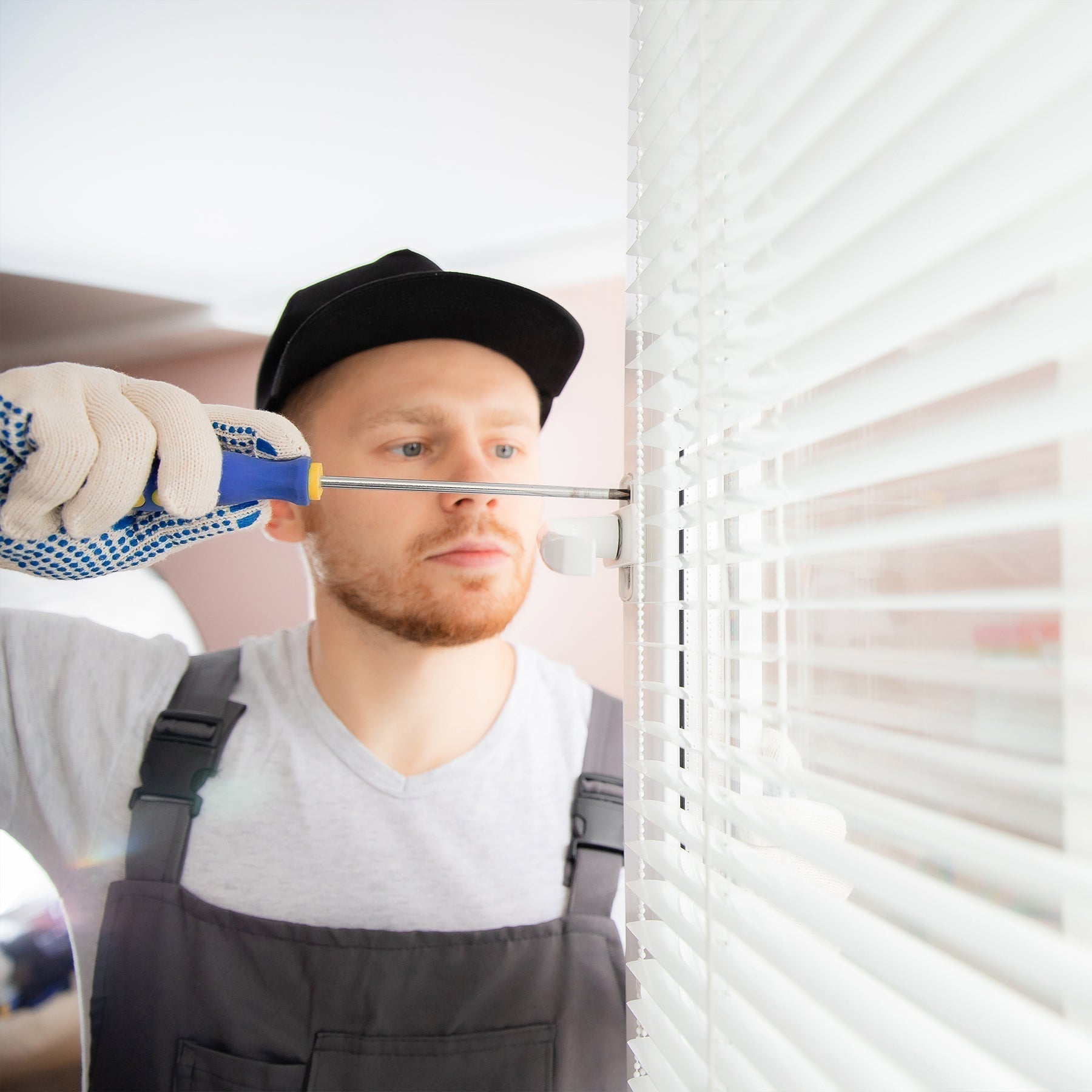Having trouble fixing broken blinds? Explore our blog for step-by-step guides to repair your window coverings—no drill roller shades, cordless cellular shades, cordless zebra shades, and PVC mini blinds included. Learn how to operate them correctly or revive them.
How to Fix No Drill Roller Shades

No drill roller shades at Hestiablinds are designed for a simple, tool-free installation and smooth operation. If you're running into a snag, this guide will help you get your shade working perfectly again.
My No Drill Roller Shade Won't Roll Back Up
Featuring a retractable design, our roller shades can roll up automatically with a simple touch. Give the handle a gentle, quick tug downward and then immediately let go. Don't pull it all the way down; a short tug is all it needs to signal the mechanism to retract.

Try the gentle tug a few times to get the feel for it. In some cases, the roller mechanism might be broken or installed incorrectly. If you've tried several times and the issue persists, please reach out to our customer service team for further assistance.
My No Drill Roller Shade Rolls Up Too Slowly/Quickly
The retraction speed of our no drill roller shade is adjustable. Locate the small hole on the right side of the headrail—this is the speed-adjustment mechanism. To slow the raise, turn clockwise; to speed it up, turn counterclockwise.

My No Drill Roller Shade Won’t Roll All the Way Up to the Top
You may notice the roller shade raises but stops short of the top rail. To fix this, adjust the upper position limit. Before adjusting, let the shade raise to its current stopping height. Then follow these steps:
1.Locate the small hole on the left side of the headrail and insert the hex wrench.
2.Turn the wrench clockwise; the shade will continue to rise from its current position. To set a lower upper stop, turn it counterclockwise.
3.When it reaches your desired position, stop turning.
The upper limit is now reset. The shade will stop at the new height the next time it raises.

How to Fix Cordless Cellular Shades

My Cellular Shades Hang Unevenly
If your shades are hanging unevenly, try this simple fix:
1.Lower the Shade: Pull the shade all the way down until it can't lower any further.
2.Firmly Tug: Give the shade a few firm tugs. This action will help level the bottom rail and reset the tension device, restoring balance to your shades.
To avoid this issue in the future, always lift your shades from the center rather than the sides. Additionally, be cautious not to lift too quickly, as this can create slack in the cords and lead to uneven hanging.
My Cellular Shades Won't Lift
If your shades are refusing to lift, a gentle pull on the bottom rail can often resolve the issue. This action will reactivate the tension spring, allowing your shades to function properly again.
Keep in mind that if your blinds have been left in the closed position for a long time, the spring may need to be reset to ensure optimal performance.
How to Fix Cordless Zebra Shades

Zebra shades rolling crooked or not moving evenly? Here’s a simple, fix-it-yourself guide to get them gliding straight again.
Start by spotting the culprit common reasons zebra shades act up:
- The headrail or brackets aren’t level.
- The fabric is “telescoping” — it walks to one side as it rolls.
- The top wrap of fabric got started crooked during installation or after a snag.
Fix the basics first:
- Check for level: Loosen the bracket screws, shim if needed, and retighten. Make sure the shade is fully clicked into both brackets. If you have a cassette, reseat it so it’s square.
- Make sure nothing is bumping the shade: Confirm the bottom rail isn’t catching on window handles, locks, or trim.
Re-center the fabric on the tube:
- Lower the shade completely so the bands are visible and relaxed.
- Gently pull the bottom rail down another inch to remove slack, then guide the rail left/right slightly as you raise it a foot. This can re-center a minor skew.
- Repeat once or twice. If it keeps tracking to one side, use the tape correction below.
The tape trick for telescoping is the go-to fix when the fabric drifts as it rolls up.
- First, note which way the fabric is drifting.
- Lower the shade fully. If you have a fascia/front cover, pop it off.
- Add 1–3 small layers of masking tape on the bare roller tube at the opposite end from the drift, about 1/4 inch in from the edge.
-If the fabric tracks to the right, put tape on the left end of the tube.
-If it tracks to the left, put tape on the right end.
- Test by raising and lowering. Add or remove a layer until the fabric rolls true. Snap the front cover back on.
Final clean-up checks:
- Make sure the bottom rail isn’t hitting window handles, locks, or trim.
- Wipe the bands and edges with a clean microfiber cloth to remove debris that can steer the roll.
Tips for operating cordless zebra shades:
- Use the handle to raise or lower the shade. If you must pull the bottom rail, grasp the center rather than the sides.
- If the handle has shifted to one side, slide it back to the center before adjusting the shade.
How to Fix Cordless PVC Blinds

Troubleshooting Horizontal Blinds that Won't Open
When your horizontal blinds do not operate smoothly, the first thing to check is the ladder cords that run between the slats. Over time, dust and oils can accumulate on these cords, leading to poor performance. To restore functionality, use a soft brush or a clean cloth to gently wipe down the cords, ensuring they are clean and free of debris.
Another common issue may be related to the string not being properly wound around the plastic wheel inside the headrail. If you notice any slack in the string, carefully wind it back onto the wheel, reattach the blinds, and they should operate smoothly once again.
Fixing Broken Slats
If you have broken slats, you can often use glue or repair adhesive to fix them. For more severe deformations, consider using a hot drying oven or a heat gun to reshape the slats.
In cases where the broken slats are beyond repair, you might opt to replace them. Here’s a simple process to follow:
1.Untie Knots: Untie the lift string knots from the underside of the bottom rail.
2.Replace Broken Slats: Pull the string up through the last damaged slat and remove the broken slats. Replace them with the new slats, ensuring that the route holes are aligned with the existing slats.
3.Insert the String: Feed the string through the bottom rail and tie it off securely.
4.Test: Raise and lower the blinds to confirm the repair is successful.
Restringing a Blind
If the string is frayed but still intact, you won’t need to remove the entire blind. Follow these straightforward steps to restring it:
1.Prepare New Strings: Determine the length of each string needed for the repair by following this formula: (2 x blind length) + blind width.
2.Cut Old String: Pull the old string out gently and cut it above the knot.
3.Fuse Strings: Use a lighter or match to fuse the ends of the new and old strings together.
4.Tie Knot: Tie a knot at the end of the new string.
5.Pull Through: Pull the string through the blind until the knot on the new string is seated at the bottom of the blind.
6.Trim Excess: Cut off the excess old string.



Share:
How to Clean Fabric Shades
The Correct Way to Use Your Window Shades That Can Extend their Lifespan